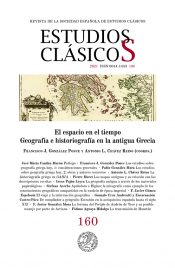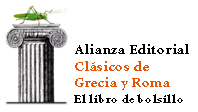APOLODORO E HIGINO: LA MITOGRAFÍA COMO EJEMPLO DE LOS CONOCIMIENTOS GEOGRÁFICOS COMPARTIDOS EN LA ΠΑΙΔΕΙΑ DE ÉPOCA IMPERIALApollodorus and Hyginus: mythography as an example of shared geographical knowledge in the imperial παιδεία
Stefano Acerbo
Resumen
El examen de las obras de los mitógrafos de la edad imperial puede ofrecer un material útil para valorar la influencia de la geografía científica en la παιδεία griega y romana. El presente artículo se centra, en particular, sobre la Biblioteca de Apolodoro y las Fábulas de Higino destacando los puntos de contacto entre ellas, pero, sobre todo, sus diferencias. Algunos pasajes de la Biblioteca y, en particular, la breve reseña doxográfica que abre la sección dedicada a los viajes de Ulises demuestran que Apolodoro conocía algunos aspectos del debate geográfico de su tiempo y no era del todo ajeno a las actitudes científicas y filológicas sobre cuestiones geográficas que se remontan a la época helenística. Por el contrario, Higino no parece manejar la geografía mítica con igual competencia. Su interés principal consiste en el acercar la mitología griega al mundo de sus lectores latinos y, por los tanto, los lugares del mito le interesan sobre todo cuando pueden ser ubicados en Italia o en las regiones cercanas. En estos casos las Fábulas, aunque a veces pueden preservar detalles raros y valiosos, normalmente se limitan a aludir de manera rápida a los lugares visitados por los héroes, sin ofrecer casi ninguna referencia geográfica.
Palabras clave: Ulises; Mitografía; Geografía; los Argonautas
Abstract
The study of the writings of the mythographers of the imperial age can provide us with useful material for assessing the influence of scientific geography on Greek and Roman παιδεία. This article will focus, in particular, on the Library of Apollodorus and on the Fables of Hyginus, showing their contact points, but, above all, their differences. Some passages of the Library and, in particular, the brief doxographical overview that opens the section devoted to the journeys of Odysseus show that Apollodorus was well aware of some aspects of the geographical debate of his time, as well as of the scientific and philological discussions on geographical issues that date back to the Hellenistic period. On the other hand, Hyginus does not seem to handle mythical geography with equal competence. His main interest consists of bringing Greek mythology closer to the world of his Latin readers, and therefore the places of myth are of interest to him above all when they can be located in Italy or in the neighboring regions. In these cases, sometimes the Fables may preserve rare and precious details. However, mostly a quick allusion to the places visited by the heroes is enough to the author, with almost no geographical reference.
Keywords: Mythography; Geography; Odysseus; the Argonauts
Referencias bibliográficas
Bibliografía
Acerbo, S. (2019) Le tradizioni mitiche nella Biblioteca dello ps. Apollodoro. Percorsi nella mitografia di età imperiale, Amsterdam, Hakkert.
Acerbo, S. (2020) «One or more representations of the World? A study of mythical geography in the Library», en M. Albaladejo (ed.) NON SUFFICIT ORBIS Geografía histórica y mítica en la antigüedad, Madrid, Dykinson, 177-188.
Antonelli, L. (1995) «Le localizzazioni della Nekyia di Odisseo (un itinerario sulle tracce degli Eubei)», en L. Braccesi (ed.), Hespería. Studi sulla Grecità di Occidente 5, Roma, Erma di Bretschneider, 203-222.
Boriaud, J.Y. (1997) Hygin. Fables, Paris, Les Belles Lettres.
Bowie, E.L. (1973) «The Greeks and Their Past in the Second Sophistic», Past and Present 66, 3- 41.
Braccesi, L. (2001) Hellenikòs Kolpos. Supplemento a Grecità Adriatica, Roma, Erma di Bretschneider.
Braccesi, L. (2010) Sulle rotte di Ulisse. L’invenzione della geografia omerica, Bari, Laterza.
Buonajuto, A. (1996) «L’ ΕΞΩΕΑΝΙΣΜΟΣ dei viaggi di Odisseo in Cratete e negli Alessandrini», Atene e Roma 41, 1-8.
Cameron, A. (2004) Greek Mythography in the Roman World, Oxford – New York, Oxford University Press.
del Hoyo J. – García Ruiz, J.M. (2009) (eds.) Higino Fábulas, Madrid, Gredos.
del Hoyo, J. (2009) «Contradicciones internas en las Fabulae de Higino», en M. A. Almela Lumbreras et alii (eds.) Perfiles de Grecia y Roma: actas del XII Congreso Español de Estudios Clásicos, Valencia, 22 al 26 de octubre de 2007, Madrid, Sociedad Española de Estudios Clásicos.
Desmedt C. (1970) «Fabulae Hygini», Revue belge de Philologie et d’Histoire 48, 26-35
Edmunds, L. (2017) «Helen in Pseudo-Apollodorus Book 3», en J. Pàmias (ed.) Apollodoriana. Ancient Myths, New Roads, Berlin – Boston, De Gruyter, 82-99.
Fowler, R.L. (2013) Early Greek Mythography. Volume 2: Commentary, Oxford, Oxford University Press.
Fowler, R.L. (2017) «Apollodorus and the Art of the Variant», en J. Pàmias (ed.) Apollodoriana. Ancient Myths, New Crossroads, Berlin – Boston, De Gruyter, 158-175.
Fletcher, K.F.B. (2013) «Hyginus’ Fabulae: Toward a Roman Mythography», en S. M. Trzaskoma & R. S. Smith (eds.) Writing Myth. Mythography in the Ancient World, Leuven, Paris, Walpole (MA), Peeters, 133-164.
Frazer, J.G. (1921), Apollodorus, The Library, London – New York, Heinemann.
Gasti, F. (2017), Igino. I miti del mondo classico, Roma, Rusconi.
Mactoux, M.M. (1989) «Panthéon et discours mythologique. Le cas d’Apollodore». Revue d’Histoire des Religions 206, 245–270.
Marek, B. (2017), «The Hermeneumata (Pseudodositheana) and their didactic use», AUC Philologica 2, 127-152.
Marshall, P.K. (2002), Hyginus. Fabulae, Munich – Leipzig, Teubner.
Mascoli, P. (2002) «Igino bibliotecario e gli Pseudo Igini», Invigilata Lucernis 24, 119-125.
Nakassis, D. (2020) «Homeric Geography», en C. O. Pache, C. Dué, S. Lupack, R. Lamberton (eds.) The Cambridge Guide to Homer, Cambridge, Cambridge University Press.
Prontera, F. (1993) «Sull’esegesi ellenistica della geografia omerica», in G. W. Most, H. Petersmann, A. M. Ritter (eds.) Philanthropia kai Eusebeia. Festschrift für Albrecht Dihle zum 70. Geburtstag, Göttingen, Vandenhoeck & Ruprecht, 387–97.
Romm, J.S. (1992) The Edges of the Earth in Ancient Thought: Geography, Exploration, and Fiction, Princeton (NJ), Princeton Unversity Press..
Rose, H.I. (1933) Hygini Fabulae, Leyde, Sijthoff.
Rossignoli, B. (2004) L’Adriatico Greco, culti e miti minori, Roma. Erma di Bretschneider.
Scarpi, P. (1999) «L’Italia di Apollodoro. Sterilità mitologica di Roma e rappresentazione dell’Italia centro-meridionale», in G. Avezzù, E. Pianezzola (eds.) Sicilia e Magna Grecia. Spazio reale e spazio immaginario nella letteratura greca e latina, Padova, Imprimitur, 1-16.
van der Valk, M.H. (1958) «On Apollodori Bibliotheca», Revue des Études Grecques 71, 100-68.
Vitelli Casella, M. (2019) «Tra mito e toponomastica: le isole Apsirtidi, Apsaros e Tomi», Wiener Studien 132, 29-46.
Revista
-
Sobre la revista
Página principal
-
Estatutos
Estatutos de la Revista Estudios Clásicos
-
Código ético
Declaración de buenas prácticas
-
Normas de recepción y envío
Indicaciones para envíos de artículos
-
Equipo editorial
Consejos de redacción y asesor
-
Comité de honor
Comité de honor
Información
-
Para autores
Publicar con nosotros
-
Para evaluadores
Normas para evaluar artículos
-
Para bibliotecas
Información bibliográfica
-
Contacto
Cuestiones y preguntas
Publicar en EClás
-
Envío de originales
Artículos y reseñas
-
Normas de publicación
Descarga normas en PDF
-
Estilo CSL EClás
Estilo CSL EClás
-
Índices de calidad
Bases de datos e impactos


 c/ Serrano, 107
c/ Serrano, 107